Genre: Platformer Developer: Core Design Publisher: Virgin Games Players: 1 Released: 1991
The early nineties saw a sudden influx of “Jurassic period meets modern times” content into the media. Whether it was books like Dino Park, movies like Encino Man or TV shows like Dinosaurs, suddenly it seemed like there were cavemen and dinosaurs everywhere – and they were immensely popular. Of course, video games did not elude that trend. One of the most successful home computer games of that era was a little platformer by pre-Tomb Raider Core Design: Chuck Rock. Originally Released in 1991 for Amiga and Atari ST, this game was a huge success. In consecutive years, this title was ported to almost every system available at that period (from Acorn Archimedes to Super NES), the Sega Genesis, notwithstanding.
Let me start with the best first: Chuck Rock has got a bitchin’ main theme! When you boot the game, you are greeted by a stone-age rock band presenting you one of the best pieces of main menu music that has ever graced the Genesis. Every now and then I like to pop in the cartridge, just to listen to the main theme. Now, with an opening like that, what does that promise for the game itself?
Chuck is your average slack-jawed, leaf-wearing, beer-bellied cavemen. One day, his busty, blonde, and beautiful wife Ophelia (keyboarder in the intro-band) gets kidnapped by the villainous T-Rex Gary Gritter (a not-too-subtle reference to British musician, the garish Gary Glitter). In order to safe his betrothed, our mohawked hero has to set out through five different stone age-themed levels; amongst others, he journeys through the inside of a dinosaur. Not all the critters in the game are enemies. Along on his way, an apatosaur, a whale, or a pterodactyl helps our protagonist over short, otherwise impassable hindrances. As you might have guessed, the game is highly cartoonish in its presentation. (The Sega CD version of the game also includes a narrated intro where you witness Chuck’s wife being kidnapped while our hero sits lazily in front of his TV. Why this intro isn’t there in the Genesis version I can’t understand; you could’ve just cut out the narrator and it would’ve been just as fine).
Chuck has three manners of attack at his disposal. First, he can bounce enemies away with his mighty beer belly. While funny to look at (and underscored with a nice bouncing sound effect), this attack is relatively useless due to its incredibly short range and the fact that he has to stand still for this. Therefore you’re more likely to use the second form, which is a jumping kick. This one not only has the advantage of a slightly larger range, but Chuck can also move forward or change directions while airborne. Lastly, our protagonist is able to pick up and… chuck rocks (harr-harr).
The chunks of stone are available at a small and a larger size (Chuck moves considerably slower while carrying a large rock around). Dispatching enemies by throwing stuff at them takes a bit of practice since the rocks don’t travel far; you can only chuck them in a slow arc. Most of the times, you need these pieces of granite to reach higher platforms or bypass traps. Unfortunately, there are one or two instances where you can get stuck, such as when you’ve accidentally thrown a rock up on a ledge that you can’t reach without it. Since they don’t respawn, in these cases all you can do is kill yourself and start the stage again. It doesn’t happen very often, though.
All in all, the game is very short and moderately easy. To make the levels a little more challenging, the developers employed some cheap tactics. Since the attack range of our hero is incredibly limited, it might take some time before you can take out the critters in the game effectively. Also, sometimes you have to make leaps of faith only to end up right in an enemy or a trap, or enemies are hidden behind passable objects. In both cases you blindly run into them and take damage. So your best tactic is to always kick attack whenever to have to jump off something or move behind some object. Basically the same applies to the boss battles: All the bosses have limited patterns that are rather easy to learn and overcome, so in order to up the ante, the programmers increased their life bar; the final boss takes twenty hits to take out! Considering the incredibly short range of your attacks, defeating this boss seemingly takes forever. Once you know where to stand, though, the last boss is a joke.
The graphics are pretty nice. The cartoonish look and the stone age touches go together pretty well, and at times the game is very pretty to look it. The sound and music are also very well implemented (Chuck starts every level with a trademark “unga-bonga” voice sample that comes off very clearly). However, both are incredibly limited. Every level has only one background theme, and while pretty good, they unfortunately don’t reach the quality of the main theme (also, the music of first and third level sound awfully similar). Regarding the sound effects, there are very few, all of which you’ll hear constantly throughout the game; a little more diversity would’ve been nice.
As I said, back in its day, the game was highly successful and very popular across all the platforms it was ported to. It also saw two successors (Son of Chuck and the Mario Kart clone B.C. Racers). Its incredible fame, however, came in large part due to the stone age fad going on back in the nineties. Take that away, and you have a nice, at times funny little platformer that unfortunately has a few very cheap sections and, once you’re able to overcome those, is rather short. I’d recommend having a go, listen to the main theme, and have a short look at the nice graphics. All in all, though, this game is only slightly above average.
SCORE: 6 out of 10

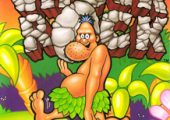
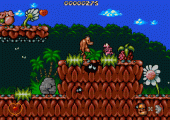
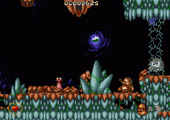
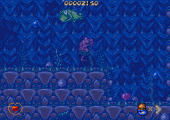
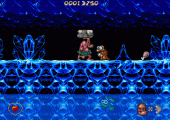
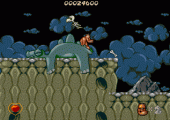
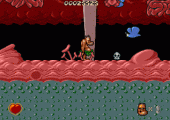
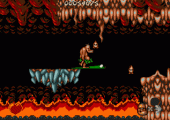
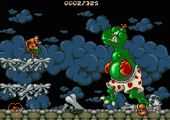
Recent Comments